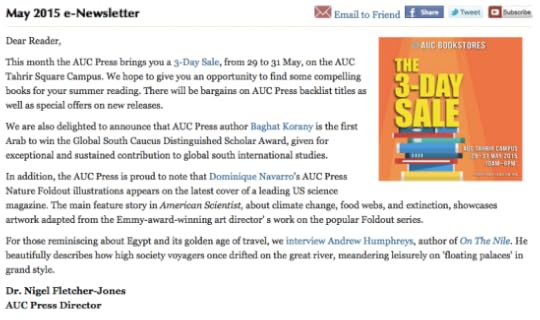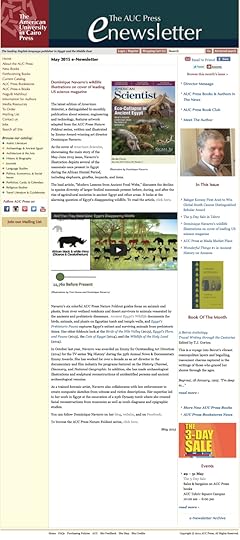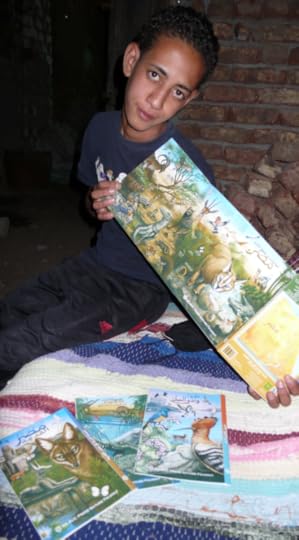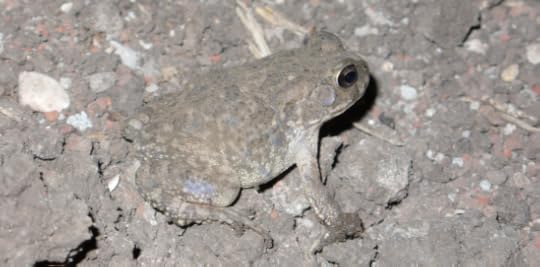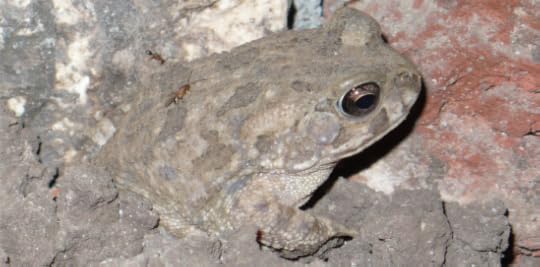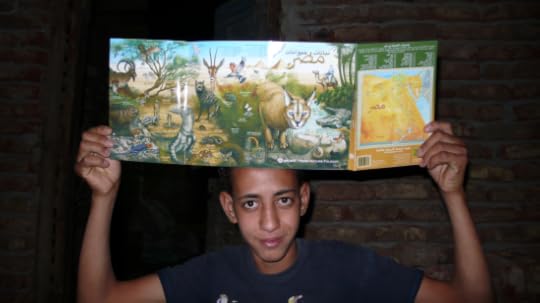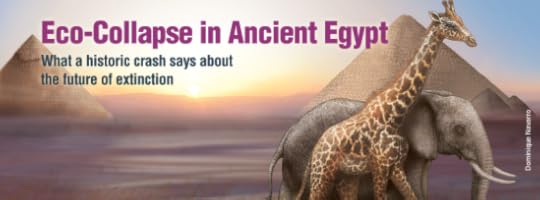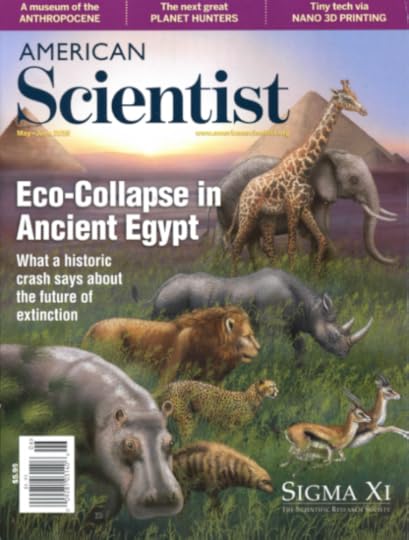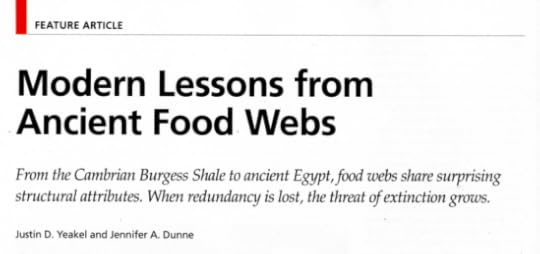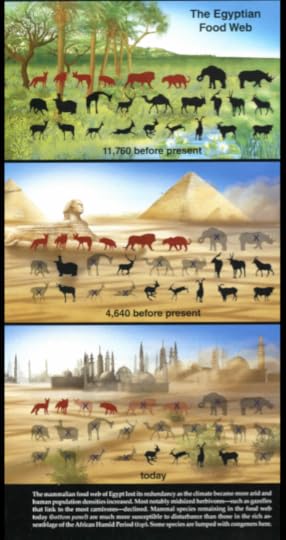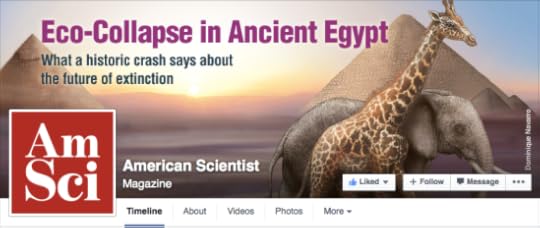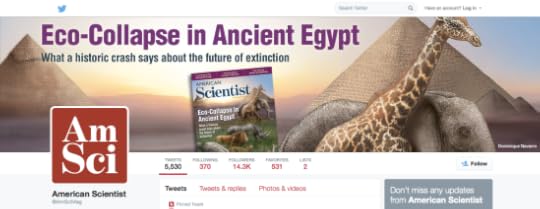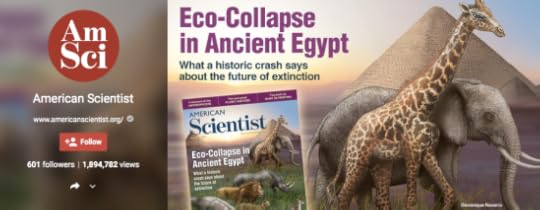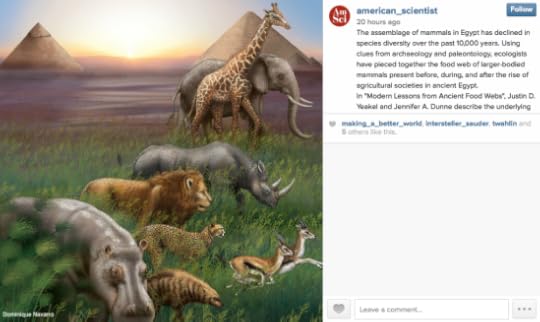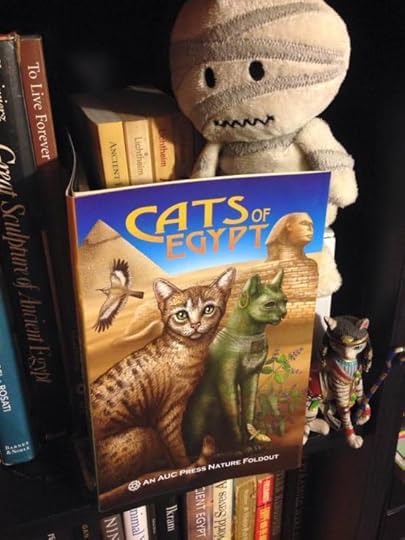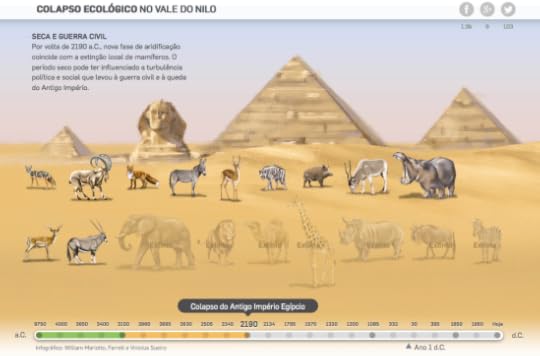Dominique Navarro's Blog, page 12
May 11, 2015
AUC Press E-Newsletter — Dominique Navarro’s wildlife illustrations on cover of leading US Science Magazine
The AUC Press is proud to note that Dominique Navarro’s AUC Press Nature Foldout illustrations appears on the latest cover of a leading US science magazine. The main feature story in American Scientist, about climate change, food webs, and extinction, showcases artwork adapted from the Emmy-award-winning art director’ s work on the popular Foldout series.
Filed under: AUC Press Nature Foldout News Updates








May 9, 2015
Abdulazim and the Arabic Nature Foldouts
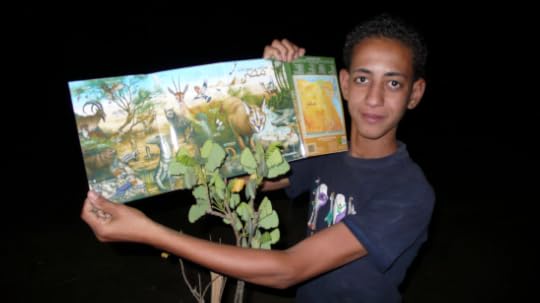 Abulazim holding the Nature Foldout next to a Cassia surattensis small tree.
Abulazim holding the Nature Foldout next to a Cassia surattensis small tree.
Sat with teenager Abdulazim during sunset in Luxor, listening to the folk music of Rabea Albarka and observing various wildlife including a barn owl (Tyto alba), frog (Bufo regularis), and scarab (Scarabaeus sacer). Fun to share the Arabic Nature Foldouts with him and identify the species.
A very small frog, possibly Bufo regularis, in Luxor near the agricultural fields. It has a deep, very loud croak.
Abdulazim would appreciate the news: the Arabic version of the foldouts may soon be available in Egypt, insh’allah! More updates to follow…
Filed under: AUC Press Nature Foldout News Updates








April 16, 2015
How Can Art Move Us Beyond Eco-Despair? An Article in the Current Issue of American Scientist Magazine
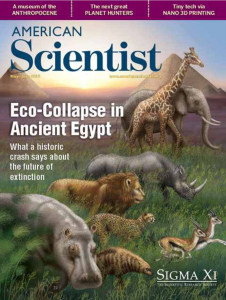 Cover Art by Dominique Navarro
Cover Art by Dominique Navarro
Grim news about climate change easily triggers a sense of helplessness. Art can help redirect that feeling into one of active engagement.
https://www.americanscientist.org/issues/pub/how-can-art-move-us-beyond-eco-despair
A June 2014 study by social scientists charts the ill effects of climate change on people���s emotional states. Beyond Storms and Droughts: the Psychological Impacts of Climate Change , a 50-page report by the American Psychological Association (APA), gauges human reactions to environmental disturbance and catastrophe. At the community level, it finds climate change causing a loss of social cohesion, as well as increased violence, crime, social instability, aggression, and domestic violence. This bleak catalogue of ills mainly afflicts people whose communities have been devastated by climate change���induced fire or flood or hurricane, even more so for the poor and alienated. Feeling beset upon and hopeless, their very identity and autonomy become threatened, with manifestations of post-traumatic stress syndrome. Our planetary disturbance infiltrates our inner lives, with alarming and often unacknowledged effects.
These social ills have been with us for a long time. But today, for those of us who are fully aware of���who are dreading���the seemingly inevitable unfolding of climate change, the consequences may be even more personal and interior. The APA report refers to this condition as ���ecoanxiety��� and cites a trio of disastrous symptoms: helplessness, fatalism, and resignation. This is what a lot of us feel. We may not put a name to it, but a sure sign of ecoanxiety is the humorless tone of environmental discourse. I would label this state as eco-depression, or more dramatically, eco-despair. I suspect anyone paying close attention to ecological effects feels it.
Eco-despair presents an interesting challenge. We want to remain engaged in actions that work to understand and communicate, as well as to reverse or slow climate change���but taking action requires excitement, and often a sense of mission. Keeping up protracted, often fractious connections to others can drain a lot of energy. Depression of any sort can sap motivation and leave one isolated with a triumvirate of mental pains: that ���helplessness, fatalism, and resignation��� that can leave one overwhelmed, bitter, and cynical. How might we treat eco-depression?
Art can help here���specifically, a certain kind of art that deliberately depicts and imaginatively confronts us with climate change. Ecologically aware art, presented in many places and across multiple media, can shift our perspective. It can pose fresh, liberating questions and connect us to the inner consciousness of another fully engaged, sensitive human viewer of our shared problem.
Read the whole article: https://www.americanscientist.org/issues/pub/how-can-art-move-us-beyond-eco-despair
Filed under: Egypt News - Environment & Egyptology, Related Stories








April 15, 2015
The American Scientist Magazine May–June 2015 with Cover Illustration by Dominique Navarro, from the AUC Press Nature Foldouts
EXTRA! EXTRA! The American Scientist Magazine http://www.americanscientist.org/ May–June 2015 Issue is HOT off the press and available for your reading pleasure! In this exciting issue you’ll find the cover article, illustrated by Dominique Navarro, “Modern Lessons from Ancient Food Webs” that discusses the decline in species diversity of larger-bodied mammals present before, during, and after the rise of agricultural societies in ancient Egypt and other areas.
The article can be purchased and read at: bit.ly/1y8gz0L
The assemblage of mammals in Egypt has declined in species diversity over the past 10,000 years. Using clues from archaeology and paleontology, ecologists have pieced together the food web of larger-bodied mammals present before, during, and after the rise of agricultural societies in ancient Egypt.
In “Modern Lessons from Ancient Food Webs”, Justin D. Yeakel and Jennifer A. Dunne describe the underlying structure that appears to be consistent in food webs across space and time, as well as how we can better predict their instability or recovery after major die-offs.
American Scientist is the illustrative, award-winning magazine of Sigma Xi, The Scientific Research Society and is your source of science, technology and engineering news and features since 1913! Visit the website at http://www.americanscientist.org.
Artwork Attribution:
Artwork by Dominique Navarro, author and illustrator
of the AUC Press Nature Foldout Series
from American University in Cairo Press.
The AUC Press NatureFoldouts are illustrated foldout guides introducing an exciting selection of Egypt’s animals and plants, from river wetland residents and desert survivors, to venerated animals of the ancients and prehistoric dinosaurs.Available from online booksellers including AUCPress.com and Amazon.com.
Follow American Scientist Magazine on:
GOOGLE+
Filed under: AUC Press Nature Foldout News Updates, Egypt News - Environment & Egyptology, Press








The American Scientist Magazine May���June 2015 with Cover Illustration by Dominique Navarro, from the AUC Press Nature Foldouts
EXTRA! EXTRA! The American Scientist Magazine http://www.americanscientist.org/ May���June 2015 Issue is HOT off the press and available for your reading pleasure! In this exciting issue you’ll find the cover article, illustrated by Dominique Navarro, “Modern Lessons from Ancient Food Webs” that discusses the decline in species diversity of larger-bodied mammals present before, during, and after the rise of agricultural societies in ancient Egypt and other areas.
The article can be purchased and read at: bit.ly/1y8gz0L
The assemblage of mammals in Egypt has declined in species diversity over the past 10,000 years. Using clues from archaeology and paleontology, ecologists have pieced together the food web of larger-bodied mammals present before, during, and after the rise of agricultural societies in ancient Egypt.
In “Modern Lessons from Ancient Food Webs”, Justin D. Yeakel and Jennifer A. Dunne describe the underlying structure that appears to be consistent in food webs across space and time, as well as how we can better predict their instability or recovery after major die-offs.
American Scientist is the illustrative, award-winning magazine of Sigma Xi, The Scientific Research Society and is your source of science, technology and engineering news and features since 1913! Visit the website at http://www.americanscientist.org.
Artwork Attribution:
Artwork by Dominique Navarro, author and illustrator
of the AUC Press Nature Foldout Series
from American University in Cairo Press.
The AUC Press NatureFoldouts are illustrated foldout guides introducing an exciting selection of Egypt���s animals and plants, from river wetland residents and desert survivors, to venerated animals of the ancients and prehistoric dinosaurs.Available from online booksellers including AUCPress.com and Amazon.com.
Follow American Scientist Magazine on:
GOOGLE+
Filed under: AUC Press Nature Foldout News Updates, Egypt News - Environment & Egyptology, Press








April 14, 2015
And Then They Were Gone: Egypt’s Disappearing Wildlife — The American Scientist Magazine Video with Illustrations by Dominique Navarro, from the AUC Press Nature Foldouts
And Then They Were Gone: Egypt’s Disappearing Wildlife — The American Scientist Magazine Video
Illustrations by Tom Dunne and Dominique Navarro.
Using fossils and depictions in ancient art, Justin Yeakel and his colleagues reconstructed the food web of larger-bodies mammals over the past 11,000 years. As the climate became more arid and human population densities increased, the mammalian food web of Egypt lost its redundancy as more animals became locally extinct. Most notably, midsized herbivores—such as gazelles and antelope that link to the most carnivores—declined. Animals that are herbivores are outlined in green; carnivores are red.
The food web today is much more unstable, meaning any one extinction could lead to more domino-effect extinctions, than the rich assemblage during the African Humid Period, where we begin.
To keep this conceptual schematic elegant, we made a few simplifications: The order of the extinctions is not exact, though the assemblages shown at the three time steps is correct, and a few of the species present at some point over the time frame covered were left out due to limited space.
The article can be purchased and read at: bit.ly/1y8gz0L.
American Scientist is the illustrative, award-winning magazine of Sigma Xi, The Scientific Research Society and is your source of science, technology and engineering news and features since 1913! Visit our website at http://www.americanscientist.org.
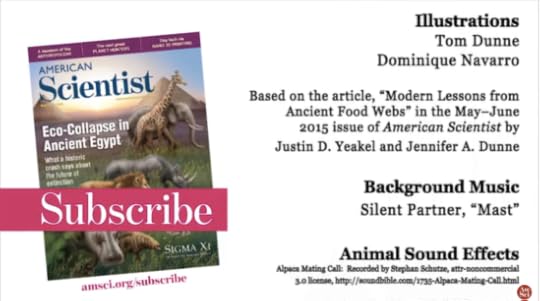
Filed under: Egypt News - Environment & Egyptology, Related Stories








And Then They Were Gone: Egypt���s Disappearing Wildlife ��� The American Scientist Magazine Video with Illustrations by Dominique Navarro, from the AUC Press Nature Foldouts
And Then They Were Gone: Egypt���s Disappearing Wildlife ��� The American Scientist Magazine Video��
Illustrations by Tom Dunne and Dominique Navarro.
Using fossils and depictions in ancient art, Justin Yeakel and his colleagues reconstructed the food web of larger-bodies mammals over the past 11,000 years. As the climate became more arid and human population densities increased, the mammalian food web of Egypt lost its redundancy as more animals became locally extinct. Most notably, midsized herbivores���such as gazelles and antelope that link to the most carnivores���declined. Animals that are herbivores are outlined in green; carnivores are red.
The food web today is much more unstable, meaning any one extinction could lead to more domino-effect extinctions, than the rich assemblage during the African Humid Period, where we begin.
To keep this conceptual schematic elegant, we made a few simplifications: The order of the extinctions is not exact, though the assemblages shown at the three time steps is correct, and a few of the species present at some point over the time frame covered were left out due to limited space.
The article can be purchased and read at: bit.ly/1y8gz0L.
American Scientist is the illustrative, award-winning magazine of Sigma Xi, The Scientific Research Society and is your source of science, technology and engineering news and features since 1913! Visit our website at http://www.americanscientist.org.

Filed under: Egypt News - Environment & Egyptology, Related Stories








March 29, 2015
A Note from Mari��lle of Catventure
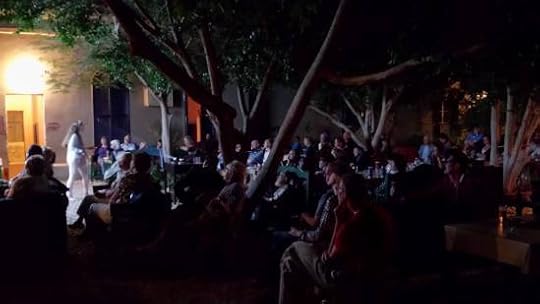 Mari��lle giving a lecture about Cats of Egypt to a captivated audience in Luxor, Egypt 2015.
Mari��lle giving a lecture about Cats of Egypt to a captivated audience in Luxor, Egypt 2015.
Received such a kind note from Mari��lle of Catventure, based out of the Netherlands. She gives lectures and presentation to educate the public on the various wild cat species of the world, as well as cats of ancient Egypt. For more info about Catventure visit her website: http://catventure.nl/ or Facebook
I was in Egypt in February and in Luxor I bought your beautiful fold-out on Cats of Ancient Egypt. I gave a lecture on Cats in Ancient Egypt twice during my trip (in Cairo and in Luxor) and though it was already prepared, I loved reading your fold out and thoroughly enjoyed looking at the beautiful drawings you made.
Thank you so much for making it :-)
Best regards,
Mari��lle
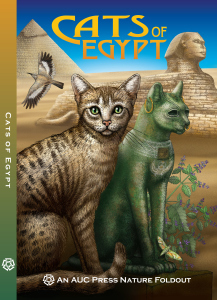 Cats of Egypt; An AUC Press Nature Foldout by Dominique Navarro with Scientific Consultant Richard Hoath
Cats of Egypt; An AUC Press Nature Foldout by Dominique Navarro with Scientific Consultant Richard Hoath
Order from AUC Press:��http://aucpress.com/p-4907-cats-of-egypt.aspx or from Amazon
Filed under: AUC Press Nature Foldout Reviews

Thanks Amelia!
Another thanks to Amelia, who posted this photo of the Cats of Egypt Nature Foldout on her wonderful bookshelf!
Cats of Egypt; An AUC Press Nature Foldout by Dominique Navarro with Scientific Consultant Richard Hoath
Order from AUC Press:��http://aucpress.com/p-4907-cats-of-egypt.aspx or from Amazon
A handy colorful guide to the wild and domestic felines of Egypt ancient and modern
Cats were just as favored in ancient Egypt as they are today. Egyptian paintings of domesticated cats date back 3,600 years, and animal cults included worship to the cat goddess Bastet. This AUC Press Nature Foldout explores wild and domestic cats of Egypt: large cats like the Cheetah, the Leopard, and the Caracal, which are all extremely threatened or near extinction within Egypt; and smaller cats including the African Wild Cat, Swamp Cat, Sand Cat, and Egyptian Mau. Whether wild or household pets, cats have long been beloved by people.
��� Each species described and illustrated, alongside examples of their natural prey in the wild
��� Map of Egypt describing the various habitats of wild cats, as well as locations of ancient Egyptian sites where the cat was worshiped and mummifed
��� Noted appearances of felines in hieroglyphs and reliefs
��� Conservation efforts for threatened cat species
Filed under: AUC Press Nature Foldout News Updates

March 6, 2015
Ecological Collapse in the Nile Valley
Fascinating Portuguese interactive website about the “ecological collapse” and extinctions of various species that were once found in the Nile Valley. (Easy to understand even if you can’t read the text.)
Explore it at http://infograficos.estadao.com.br/public/cidades/extincoes-egito/
Filed under: Egypt News - Environment & Egyptology



